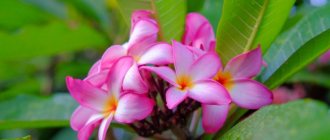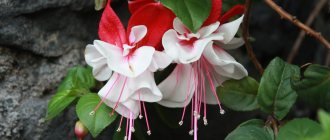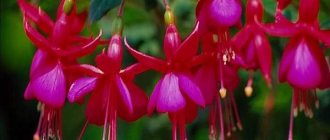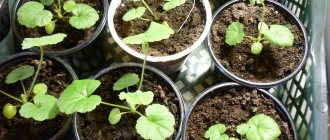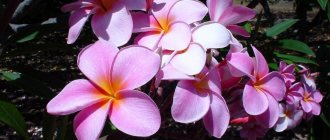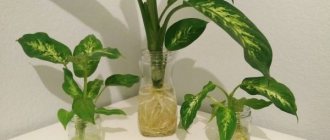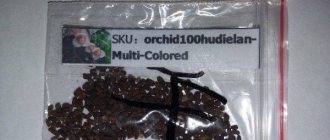Those who like large plants and have enough space for them will certainly like plumeria.
One of the easiest ways to get this flowering tree is to grow plumeria from seeds at home. The seeds have good germination, and the plants themselves develop quite quickly. In our climate, it is possible to keep plumeria only in greenhouses or indoors, because it is a true tropicana. Native to the distant Caribbean islands, this exotic plant requires above-zero temperatures all year round. But in a house that will provide the tree with beneficial comfort and warmth in winter, it feels good.
How do plumerias reproduce?
Plumerias are propagated by seeds, cuttings and grafting. Which method to choose depends on how much money you are willing to spend and how long to wait for flowering.
We have not encountered plumeria grown in Russian nurseries. So far, plumerias - unlike bougainvilleas, adeniums and some other tropical plants - are not included in the mass assortment of local nurseries. All grafted plants, cuttings and seeds for sale are imported - i.e. are imported from abroad, most often from Asian countries: Thailand, Indonesia, Vietnam. Because of this, the cost of grafted plants and cuttings is relatively high. Grafted plants come on sale in the range of 1500-4500 rubles. per plant, cuttings are rare and often cost comparable to adult plants (1500-2500 rubles/cutting, which, in our opinion, is unreasonably expensive).
Plumeria reproduces by seeds without problems. Germination is usually very good. The only point worth considering is that the seeds will not produce the variety stated in the packaging photo. Varietal characteristics are not transmitted by seed propagation in plumerias . You can get a plant that is SIMILAR in its characteristics (color and shape of petals, flower size) to the parent, but it will not be an exact copy. Keep this in mind when purchasing seeds to avoid disappointment in the future.
Pests and their control
Plumeria is poisonous, which allows it to be protected from pests and diseases. We can say that the tree has only one enemy - the spider mite.
The worst enemy of plumeria is the spider mite.
This attack in the early stages is identified as thin threads on the leaves and small dots at the bottom of the plate. If the disease is advanced, the entire plant is literally covered with cobwebs and mites. The spectacle is not for the faint of heart. The fight against ticks largely depends on the stage of its development.
When will plumeria bloom from seeds?
Plumeria from seeds is ready to bloom in about two years.
However, this does not mean that it will bloom in two years. It happens that plants refuse to bloom after 5 or 7 years. Why? This means only one thing: plumeria does not like growing conditions, namely:
– temperature regime, – light regime, – soil, – watering.
The reason for failure to bloom may be pests - most often spider mites or mealybugs.
Let us repeat again: from a biological point of view, under suitable growing conditions, a plant from seeds is ready to flower in two years. If you grow other tropical plants, for example, orchids or adeniums, and know how to warm up and add additional light to plants in the cold season, then the chances of getting flowering plumeria from seeds 20-26 months after sowing are high.
Timing and optimal conditions for planting
Plumeria is propagated in 2 ways:
- vegetative;
- seed.
The first one is simpler .
When planting seeds, you will have to put in more effort. In addition, plumeria planted in this way will bloom later. Did you know? The second name for plumeria is frangipani. The flower was named after the nobleman from Italy who first used its aroma to create perfume.
For a tropical plant, a daily 6-7 hour stay in direct sunlight is important. Therefore, when choosing a location, preference should be given to those windows in the house that can provide this condition. This may be the south or southwest side. Northern window openings are not suitable for growing plumeria - in such conditions it will refuse to bloom.
Planting seeds should be planned for early spring. In the room where seedlings and sprouts will be kept, a warm temperature should be maintained at +23...+25°C. A stronger plant should be provided with warmer conditions - +25...+30°C. With the onset of autumn, the temperature will need to be gradually reduced. In winter, during the dormant period, plumeria should be grown in conditions of +16...+17°C.
Another important condition for planting and further cultivation is high air humidity. The pot with plumeria is kept on a tray with wet expanded clay, pebbles or sand. Also, the optimal level of humidity is achieved by using a humidifier and frequent spraying from a spray bottle.
How to grow plumeria from seeds step by step
Preparing seeds for sowing
Plumeria seeds are lionfish seeds that look like maple “spouts.” The seed is quite large and easy to work with. The seeds can be light brown or dark brown. Both are acceptable. The dry light tail is very fragile. In nature, it serves so that the seed can be carried by the wind to a new place of residence. When sowing at home, the presence of a tail is not important. Therefore, if the tail crumbles during transportation, it’s okay: this does not affect the germination of the seeds in any way. When sowing at home, there is only one benefit from the tail: it helps to determine where the top and bottom of the plumeria seed are. The tail is the top.
This is what plumeria seeds look like.
Plumeria from seeds at home
Plumeria seeds
Plumeria seeds can be sown directly into the ground, but we recommend pre-soaking them in warm water (around 30 degrees) until they swell. For what? The seeds arrive from the tropics well dried to avoid rotting in transit. Therefore, in order to speed up the slow germination process, you can stimulate the seed a little.
How long and how to soak? From several hours (3-6) to several days (2-3) is enough, at your discretion. For us, the criterion that a seed is ready for planting is swelling and slightly increased size. You can add a stimulant to the water (for example, “Zircon”), but the stimulant does not globally affect the rate of seed germination.
Swollen plumeria seeds after soaking
It is convenient to germinate on a damp cloth or cotton pad. Because the seeds are large enough, the fibers of the cotton pad do not interfere, as happens with smaller seeds. Place a damp cloth in a saucer or container and place it in a warm place. A radiator is not a good idea because a hot radiator can cook the seeds. A temperature of 42-45 degrees is enough - and the risk of losing a seed increases greatly. You can use reptile mats, or place the container not directly on the radiator or heater, but at some distance. The most comfortable temperature for seed germination is 30-35 degrees .
Planting seeds
What soil should I choose for plumeria?
You can plant seeds in: Soil - it is better to choose slightly acidic soil; A universal one is also suitable - for example, Terra Vita, Aurica Gardens, etc.
You can also add perlite and vermiculite to the universal soil in approximately a ratio of 3:1:1. Vermiculite slightly acidifies the soil - this will not harm plumeria.
Perlite – it is good to germinate in perlite, but perlite itself does not have any nutritional elements, so after the seedlings emerge, the seedlings will need to be transplanted into the ground. In general, young plumeria seedlings are of good size, so there will be no problems with replanting.
Lechuza or other granules are already nutritious soil, so replanting after germination is not required. For our taste, most granules are too large for seed germination, but in general the results of germination in granules are usually quite good. Try it.
How long does it take for plumerias to sprout? Quite long - on average 2-3 weeks. Therefore, do not panic if there are no shoots after 2-3 days. The seed should be planted vertically, with the tail facing up. The seed may stick out outside; the seed itself needs to be buried about 1.5 cm and sprinkled with soil (perlite, granulate) on top.
A plumeria seedling has appeared. Now you can remove the film
Place the planted seeds in a greenhouse - you can simply cover the top with film or a lid - and place it in a warm place. Recommendations for choosing a warm place are the same as for germination: do not overheat! Light is not necessary at this stage - you don’t have to add additional lighting, you can place it away from the window. Be sure to ventilate the greenhouse 1-2 times a day for a few minutes to avoid too much air pollution. At the same time, keep the soil moist.
Plumeria shoots
Shoots appear in 2-3 weeks. You can help the sprouts free themselves from the brown seed film if they do not get out of it on their own. If the peel is difficult to remove, wet it with warm water using a cotton pad. After a few minutes the skin will come off easily.
Seedling care
How to care for plumeria seedlings? After the shoots have appeared, there is no need to make a greenhouse anymore. Now light is very important for the plant. Without light, the seedlings will stretch out and be flimsy. If the season is warm and daylight hours are long, nothing additional needs to be done. It is enough to place the seedlings on the window. If the season is cold and there is little light, it will be optimal to illuminate the seedlings with a phytolamp or an ordinary white spotlight for 10-12 hours a day. The optimal temperature at this stage is 28-32 degrees. You can use bottom heating with mats for reptiles, and a lamp will add a few necessary degrees from above.
A young plumeria seedling against the background of older plants
Plumeria from seeds, 1 month old from sowing
In the first month, you don’t need to use fertilizers, but good results are achieved by using stimulants, in particular, HB-101, succinic acid, and “Athlet.” Two treatments - once every 2 weeks - will be enough.
From about a month you can start feeding with fertilizer. At this stage, it is important for seedlings to develop the root system (phosphorus, element P in mineral fertilizers is responsible for it) and increase green mass (nitrogen, element N is responsible for it). Therefore, choose fertilizers with an NPK ratio of 20:20:12, 20:20:20. These are approximate figures, just pay attention to the ratio - either equal or more nitrogen and phosphorus than potassium.
You can feed - leaf by leaf - i.e. spraying - watering.
Frequency – once every 2 weeks. You can alternate - a week of spraying with fertilizing, a week of watering with fertilizer.
Plumeria from seeds
In general, this fertilization scheme can be maintained continuously until the seedling is one and a half years old, if your plumeria lives in “eternal summer” - with additional lighting and reheating. If you give the plant a cold winter - the temperature is below 22-25 degrees and without additional lighting, then stop feeding during the winter. At this time, the plant may shed its leaves - this is a normal reaction to coolness and lack of light, there is no reason to panic. In the spring, with rising temperatures and longer daylight hours, plumeria will again grow foliage.
From about one and a half years, you can increase the potassium content in fertilizers. Fertilizers with a minimum nitrogen content and a high potassium content, for example, NPK 8:20:26, are suitable. It is not necessary to look for these exact numbers. Just try to follow the logic: less nitrogen (first number), more phosphorus and potassium (second and third numbers). As a rule, mass-brand fertilizers for orchids (for example, Agricola) have a suitable ratio of elements.
How often should seedlings be replanted?
Transplanting a seedling from a 100 ml glass into a larger pot (200 ml)
It is worth replanting plumeria seedlings as needed, when you see that the current container is becoming cramped: the soil constantly dries out, the plant is inhibited in development, the leaves become small. It’s better not to let it get to that point and work proactively.
It is convenient to germinate seeds in 100 ml disposable cups/transport containers. This volume is enough for a couple of months, then it is better to transplant the seedlings into a larger pot.
Plumeria from seeds, 4 months old
For replanting, you can use 200 ml disposable cups, but this is not very convenient, because the root system of plumeria is fibrous, i.e. It grows not in depth, but in breadth. It is better to select a pot of approximately the same diameter and height, even if it is the same volume of 200 ml. This way the roots will develop the soil evenly.
Plumeria root system
Plumeria root system
The next transplant will be required at approximately 6 months. Use the repotting to add a slow-release fertilizer to the pot. This may be osmocote or similar granules that gradually release beneficial substances into the soil. If you are using a slow-release fertilizer, you can omit watering with fertilizers to avoid overdose, but leave foliar feeding.
Plumeria transplant
1.Seven secrets of success:
| 1. Growing Temperature: Plumeria can be grown at normal room temperature throughout the year. |
| 2. Lighting: exposure to direct rays is permissible only in the evening and morning hours; in spring and summer, during hot daytime hours, it is better to protect the plant from direct sun. |
| 3. Watering and air humidity: abundant but rather rare watering with softened water; even during the growth period, the surface of the substrate is dried to a third of its depth. Air humidity is high combined with good circulation. |
| 4. Pruning: at the end of winter - beginning of spring, formative pruning is carried out, shortening shoots that are too long, and fading buds are promptly removed. |
| 5. Soil: porous soil, which should have an acidic pH and allow moisture and air to pass well to the plumeria roots. |
| 6. Feeding: fertilizers for flowering plants 2 times a month in spring and summer. In the fall, fertilizing is reduced, and in the winter months, fertilizing is not carried out at all. |
| 7. Reproduction: by sowing seeds in spring, stem cuttings rooted in spring and summer |
Botanical name: Plumeria.
Plumeria domestica - family
Origin. Central and South America.
What it looks like. Plumerias are perennial, beautifully flowering evergreen shrubs.
The leaves are dark green, lanceolate, bent along the central vein, thick, 12–30 cm long.
Flowers up to 5 cm in diameter, with 5 elliptical petals in white, pink, yellow, red or orange, as well as in any combination of these colors, have a pleasant sweetish aroma, reminiscent of almonds. The flowers are collected in inflorescences at the tops of the stems.
Popular articles Description of juniper Tamariscifolia, planting and caring for itIn varietal plants, the diameter of flowers can reach 10 cm.
The second name of the plant is Frangipani.
Features of care during the rest period
Plumeria goes into a kind of “hibernation” in winter, which, depending on the species, lasts from three to six weeks. The plant sheds some of its old leaves, leaving a certain amount of greenery. At this time, as stated above, no fertilizing is carried out, and the plant needs to be watered only occasionally, leaving the soil slightly moist.
If you want to create an original decor for any room, you can create a florarium - a mini-greenhouse, planting in it ferns, fittonia, arrowroot, dieffenbachia, calathea, croton, moss, orchid, violet, cyclamen, rhododendron, cacti, juveniles, agave, aloe , Haworthia, Kalanchoe.
There is no need to worry if the plumeria remains dormant for more than six weeks. It all depends on the conditions of detention and the plant itself, so this period is individual for each tree. It is worth remembering that at this time the plumeria does not need to be moved to a dark place or replanted. Such actions will only harm her.
